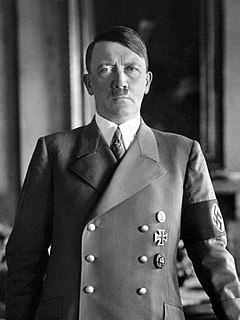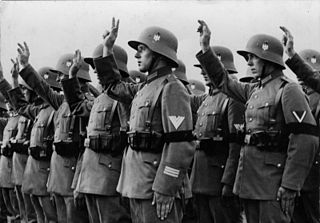
The Weimar Republic, officially named the German Reich, was the government of Germany from 1918 to 1933, during which it was a constitutional federal republic for the first time in history; hence it is also referred to, and unofficially proclaimed itself, as the German Republic. The state's informal name is derived from the city of Weimar, which hosted the constituent assembly that established its government. In English, the state was usually simply called "Germany", with "Weimar Republic" not commonly used until the 1930s.

Degenerate art was a term adopted in the 1920s by the Nazi Party in Germany to describe modern art. During the dictatorship of Adolf Hitler, German modernist art, including many works of internationally renowned artists, was removed from state-owned museums and banned in Nazi Germany on the grounds that such art was an "insult to German feeling", un-German, Freemasonic, Jewish, or Communist in nature. Those identified as degenerate artists were subjected to sanctions that included being dismissed from teaching positions, being forbidden to exhibit or to sell their art, and in some cases being forbidden to produce art.

Franz Joseph Hermann Michael Maria von Papen, Erbsälzer zu Werl und Neuwerk was a German conservative politician, diplomat, Prussian nobleman and General Staff officer. He served as the chancellor of Germany in 1932, and then as the vice-chancellor under Adolf Hitler from 1933 to 1934.

Kurt Ferdinand Friedrich Hermann von Schleicher was a German general and the last chancellor of Germany during the Weimar Republic. A rival for power with Hitler, Schleicher was murdered by Hitler's SS during the Night of the Long Knives in 1934.
The Third Position is a set of neo-fascist political ideologies that were first described in Western Europe following the Second World War. Developed in the context of the Cold War, it developed its name through the claim that it represented a third position between the capitalism of the Western Bloc and the communism of the Eastern Bloc.
Henry Ashby Turner, Jr. was an American historian of Germany who was a professor at Yale University for over forty years. He is best known for his book German Big Business and the Rise of Hitler (1985) in which he challenged the common theory that industrialists in Germany were the Nazi Party’s most influential supporters.
Karl Dietrich Bracher was a German political scientist and historian of the Weimar Republic and Nazi Germany. Born in Stuttgart, Bracher was awarded a Ph.D. in the classics by the University of Tübingen in 1948 and subsequently studied at Harvard University from 1949 to 1950. During World War II, he served in the Wehrmacht and was captured by the Americans while serving in Tunisia in 1943. Bracher taught at the Free University of Berlin from 1950 to 1958 and at the University of Bonn since 1959. In 1951 Bracher married Dorothee Schleicher, the niece of Dietrich Bonhoeffer. They had two children.

Adolf Hitler was an Austrian-born German politician who was the dictator of Germany from 1933 until his death in 1945. He rose to power as the leader of the Nazi Party, becoming the chancellor in 1933 and then assuming the title of Führer und Reichskanzler in 1934. During his dictatorship, he initiated World War II in Europe by invading Poland on 1 September 1939. He was closely involved in military operations throughout the war and was central to the perpetration of the Holocaust, the genocide of about six million Jews and millions of other victims.

Oskar Wilhelm Robert Paul Ludwig Hellmuth von Beneckendorff und von Hindenburg was a German Generalleutnant. The son and aide-de-camp to Field Marshal and Reich President Paul von Hindenburg had considerable influence on the appointment of Adolf Hitler as German chancellor in January 1933.

This bibliography of Adolf Hitler is an English only non-fiction bibliography. There are thousands of books written about Hitler; therefore, this is not an all-inclusive list. The list has been segregated into groups to make the list more manageable.

The Hitler Oath —also referred in English as the Soldier's Oath—refers to the oaths of allegiance sworn by the officers and soldiers of the German Armed Forces and civil servants of Nazi Germany between the years 1934 and 1945. The oath pledged personal loyalty to Adolf Hitler in place of loyalty to the constitution of the country. Historians view the personal oath of the Third Reich as an important psychological element to obey orders for committing war crimes, atrocities, and genocide. During the Nuremberg trials, many German officers unsuccessfully attempted to use the oath as a defense against charges of war crimes and crimes against humanity.

Adolf Hitler's rise to power began in the newly established Weimar Republic in September 1919 when Hitler joined the Deutsche Arbeiterpartei – DAP. Hitler rose to a place of prominence in the early years of the party. Being one of its best speakers, he was made the party leader after he threatened to otherwise leave.

SS-Begleitkommando des Führers, later known as the Führerbegleitkommando, was originally an eight-man SS squad formed from a twelve-man security squad tasked with protecting the life of Adolf Hitler during the early 1930s. Another bodyguard unit, the Reichssicherheitsdienst was formed 1933, and by the following year replaced the FBK in providing Hitler's overall security throughout Germany. The FBK continued under separate command from the RSD and provided close, personal security for Hitler. The two units worked together for Hitler's security and protection, especially during trips and public events, though they operated at such events as separate groups and used separate vehicles. When the FBK unit was expanded, the additional officers and men were selected from the Leibstandarte SS Adolf Hitler (LSSAH). The majority of these additional men were used by Hitler as guards for his residences while uninhabited and as orderlies, valets, waiters, and couriers.

Elard Kurt Maria Fürchtegott von Oldenburg-Januschau was a German Junker and conservative politician.

The Soviet offensive plans controversy was a debate among historians in the late 20th and early 21st centuries as to whether Joseph Stalin had planned to launch an attack against Nazi Germany in the summer of 1941. The controversy started with Viktor Suvorov with his 1980s book Icebreaker:Who started the Second World War? where he argued, based on his analysis of historical documents and data, that Stalin used Nazi Germany as a proxy to attack Europe.

Adolf Hitler, the dictator of Nazi Germany, initiated World War II in Europe with the invasion of Poland in September 1939 and was central to the Holocaust. He was hated by his persecuted enemies and even by some of his own countrymen. Although attempts were made to assassinate him, none were successful. Hitler had numerous bodyguard units over the years which provided security.
Hitler: Memoirs of a Confidant are the published memoirs written by Otto Wagener about Adolf Hitler and the Nazi Party's early history. A German major general by the end for World War II and, for a period, Wagener was Adolf Hitler's party economist, chief of staff of the SA, and confidant, whose career was derailed by rival Hermann Göring. Wagener wrote his memoirs in 1946 while being held by the British, filling “thirty-six British military exercise notebooks.” His work was not published until seven years after his death, in 1978 in German. An English edition, in which passages that aren't directly concerned with Hitler are replaced with brief summaries of the passages, was published in 1985 by Yale University Press. His memoirs are used, to some degree, by Third Reich historians.

Ernst August Paul Borsig was a German industrialist.

Adolf Hitler's cult of personality was a prominent feature of Nazi Germany (1933–1945), which began in the 1920s during the early days of the Nazi Party. Based on the Führerprinzip that the leader is always right, promulgated by incessant Nazi propaganda, and reinforced by Hitler's apparent success in fixing Germany's economic problems, his bloodless triumphs in foreign policy prior to World War II, and his quick military successes in Poland and France in the early part of the war, it eventually became a central aspect of Nazi control of the German people.














